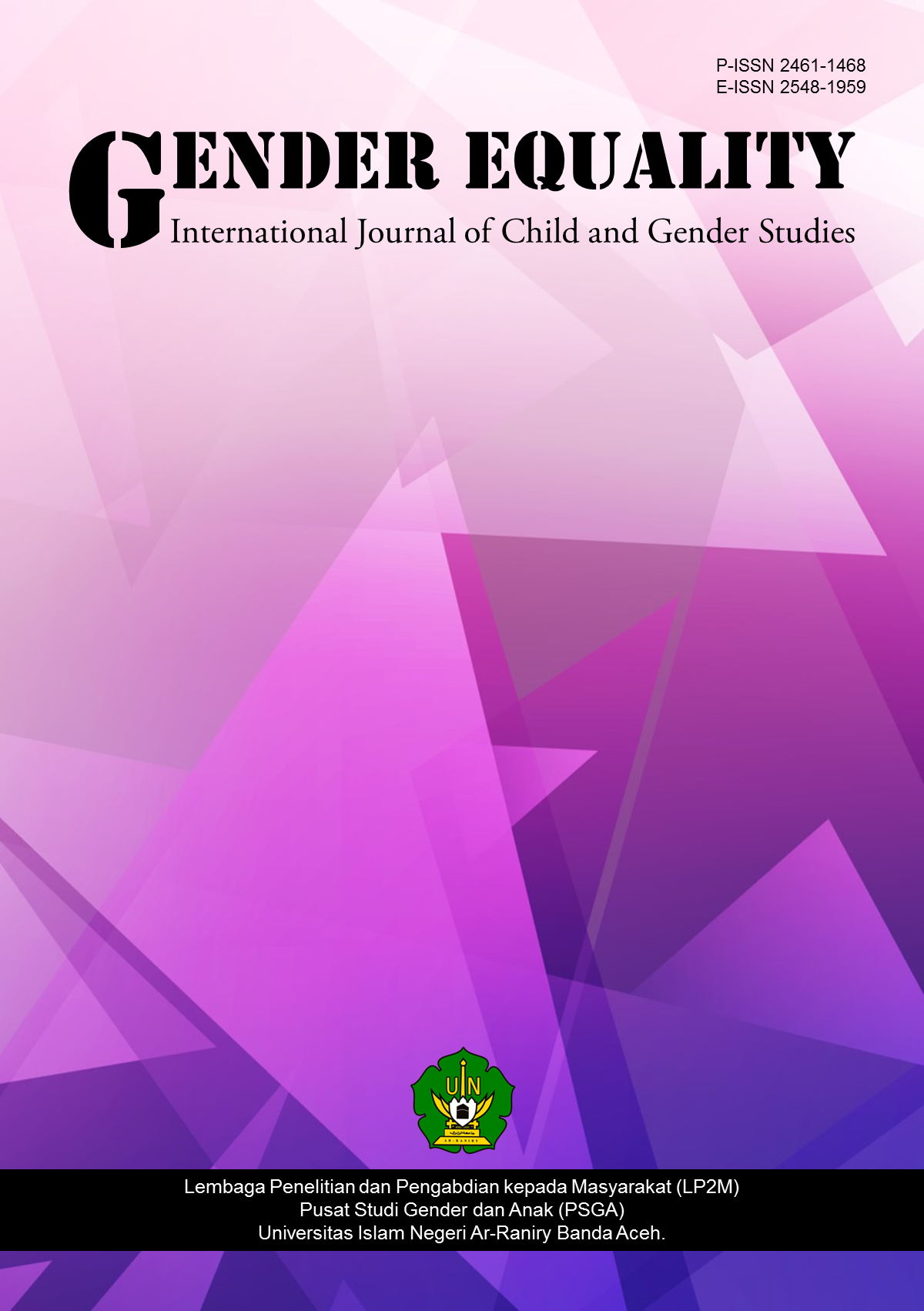BULLYING DAN KESEHATAN MENTAL PADA REMAJA SEKOLAH MENENGAH ATAS DI BANDA ACEH
DOI:
https://doi.org/10.22373/equality.v3i1.1950Keywords:
Bullying, Mental Health, AdolescentAbstract
Bullying is a form of adolescent’s negative behavior that continues to increase in school. The involvement of adolescents as the bullies are related to the mental health condition. This study aimed to find the correlation between bullying and mental health on student high school in Banda Aceh. 400 adolescents in Banda Aceh (265 females and 135 males) were invited to participated in the study were using Multi-stage Cluster and Disproportionate Stratified Random Sampling. The data was collected using The Revised Olweus Bully/Victim Questionnaire (OBVQ) and Mental Health Inventory-38 (MHI-38). The data was analyzed using nonparametric statistic with Spearman’s Rho correlation technique. The result showed that the value of correlation coefficient (r) = -0,157 with significant value (p) = 0,002 (p<0,05), which mean that there was a negative and significant correlation between bullying and mental health on adolescents’ high school in Banda Aceh. The result showed that the lower score of bullying intensity has followed the higher score of mental health, and vice versa. In conclusion, the result showed that bullying has related significantly to the mental health of adolescent. The result also showed that the majority of adolescents in Banda Aceh is at lower bullying and high mental health categorization.References
Berger, K. S. (2006). Update on bullying at school: science forgotten?. Developmental Review, 27(1), 90-126. Data Dinas Pendidikan Aceh. (2015). Persentase penduduk kelompok usia sekolah terhadap jumlah penduduk seluruhnya di 23 Kabupaten tahun 2013/ 2014. Aceh: Dinas Pendidikan Aceh. Indarjo, S. (2009). Kesehatan jiwa remaja. Jurnal Kesehatan Masyarakat, 5(1). Juvonen, J., Graham, S., & Schuster, M. A. (2003). Bullying among young adolescents: The strong, the weak, and the troubled. Pediatrics, 112(6), 1231-1237. Kaltiala-Heino, R., & Fröjd, S. (2011). Correlation between bullying and clinical depression in adolescent patients. Adolescent Health, Medicine and Therapeutics, 2, 37-44. Kaltiala-Heino, R., Rimpelä, M., Rantanen, P., & Rimpelä, A. (2000). Bullying at school—an indicator of adolescents at risk for mental disorders. Journal of Adolescence, 23(6), 661-674. Konu & Rimpelä. (2002). Well-being in schools: a conceptual model. Health Promotion International, 17(1), 79-87. Koo, H. (2007). A time line of the evolution of school bullying in differing social contexts. Asia Pacific Education Review, 8(1), 107-116. Olweus, D. (2010). In the handbook of bullying in Schools: An international perspective. Pp. 9-33. Edited by Jimerson, S. R., Swearer, S. M., and Espelage, D. L. New York: Routledge. Priyatna, A. (2010). Lets end bullying: memahami, mencegah, dan mengatasi bullying. Jakarta: PT. Elex Media Komputindo. Pusat Pelayanan Terpadu Pemberdayaan Perempuan dan Anak (P2TP2A). (2015). Jenis-jenis kekerasan anak di Aceh dari tahun 2013-2015. Laporan data tidak dipubilkasi. Aceh: P2TP2A (Pusat Pelayanan Terpadu Pemberdayaan Perempuan dan Anak). Rettew, D. C., & Pawlowski, S. (2016). Bullying. Journal Child and Adolescent Psychiatric Clinics of North America. Rigby, K., & Slee, P. T. (1993). Dimensions of interpersonal relation among Australian children and implications for psychological well-being. The Journal of Social Psychology, 133(1), 33-42. Rigby, K., & Smith, P. K. (2011). Is school bullying really on the rise?. Social Psychology of Education, 14(4), 441-455. Santrock, J. W. (2007). Remaja (Ed. 11). Terjemahan: B. Widyasinta. Jakarta: Erlangga. Setyawan, D. (2014). KPAI: Kasus bullying dan pendidikan karakter Komisi Perlindungan Anak Indonesia (KPAI). Diakses pada tanggal 31 March 2016, dari http://www.kpai.go.id/berita/kpai-kasus-bullying-dan-pendidikan-karakter/.
| Ge nder Equality: International Journal of Child and Gender Studies
Bullying dan Kesehatan Mental pada Remaja Sekolah Menengah Atas di Banda Aceh
Shetgiri, R., Lin, H., Avila, R. M., & Flores, G. (2012). Parental characteristics associated with bullying perpetration in US children aged 10 to 17 years. American Journal of Public Health, 102(12), 2280-2286. Skrzypiec, G., Slee, P. T., Askell-Williams, H., & Lawson, M. J. (2012). Associations between types of involvement in bullying, friendships and mental health status. Emotional and Behavioural Difficulties, 17(3-4), 259-272. Vanderbilt, D., & Augustyn, M. (2010). The effects of bullying. Paediatrics and Child Health, 20(7), 315-320. Veit, C. T., & Ware, Jr. J. E. (1983). The structure of psychological distress and well-being in general populations. Journal of Consulting and Clinical Psychology, 51(3), 730-742. Wright, M. F. (2016). Bullying among adolescents in residential programs and in public school: the role of individual and contextual predictors. Journal of Aggression, Conflict, and Peace Research, 8(2). Yayasan Pulih Aceh. (2015). Mengungkap fenomena bullying di lingkungan sekolah di Kota Banda Aceh. Jurnal tidak dipublikasi. The Pulihers Institute. Young, R., & Sweeting, H. (2004). Adolescent bullying, relationships, psychological well-being, and gender-atypical behavior: A gender diagnosticity approach. Sex Roles, 50(7-8), 525-537.
Downloads
Published
Issue
Section
License
GENDER EQUALITY: International Journal of Child and Gender Studies allows the author(s) to hold the copyright and to retain the publishing rights without restrictions. Authors who publish with this journal agree to the following terms:
- Authors retain copyright and grant the journal right of first publication with the work simultaneously licensed under a Creative Commons Attribution License that allows others to share the work with an acknowledgment of the work's authorship and initial publication in this journal.
- Authors are able to enter into separate, additional contractual arrangements for the non-exclusive distribution of the journal's published version of the work (e.g., post it to an institutional repository or publish it in a book), with an acknowledgment of its initial publication in this journal.
- Authors are permitted and encouraged to post their work online (e.g., in institutional repositories or on their website) prior to and during the submission process, as it can lead to productive exchanges, as well as earlier and greater citation of published work.



